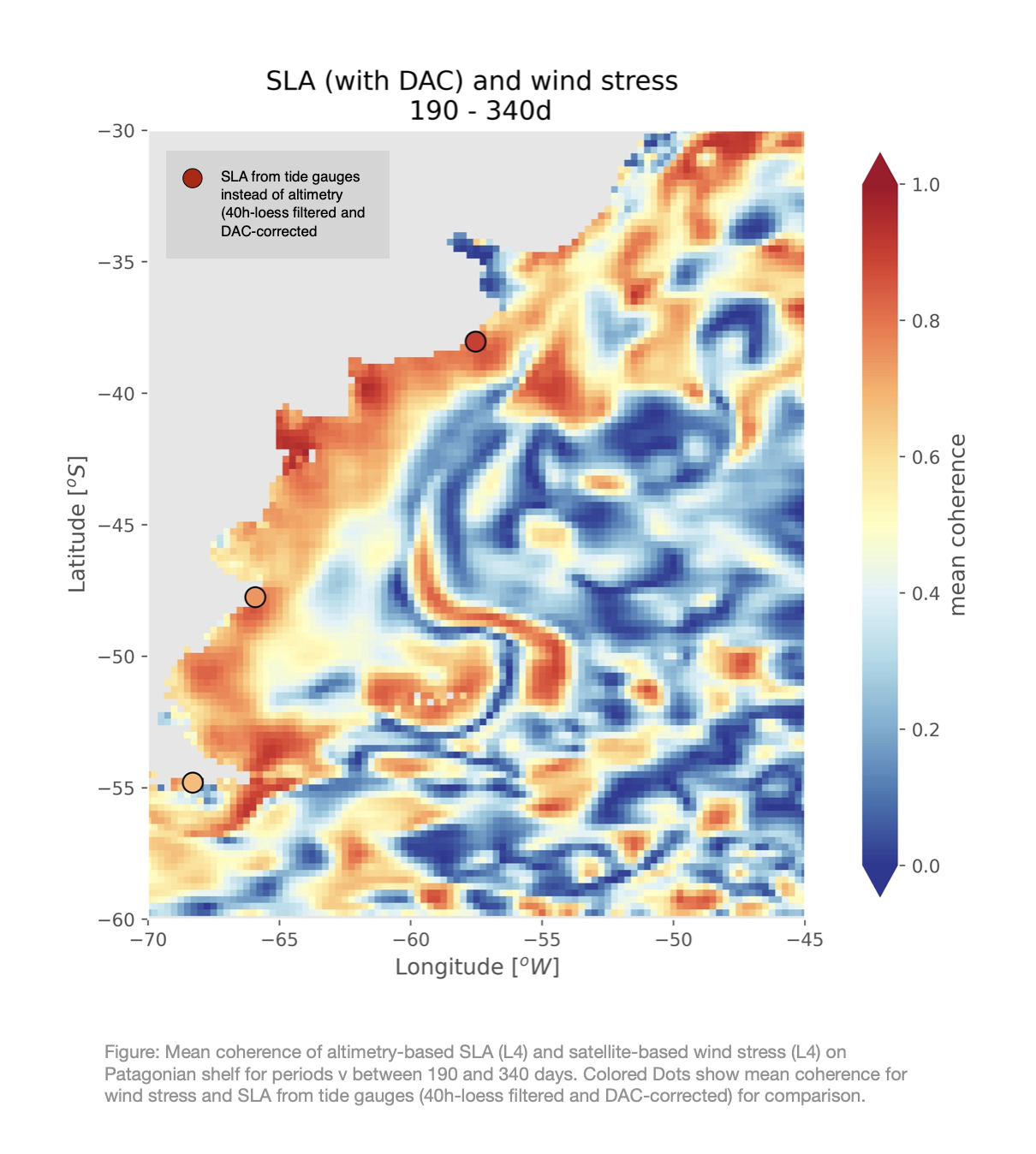Abstract's details
Impact of wind on sea level anomalies on the Patagonian Shelf coherence analysis on different temporal scales
Event: 2022 Ocean Surface Topography Science Team Meeting
Session: Coastal Altimetry
Presentation type: Poster
Sea level anomaly (SLA) differ in strength and variability not only depending on the region, but also with temporal scales. The drivers of SLA behave analogous and can be found e.g. at the low-frequencies by atmospheric pressure pattern as well as on the high-frequency end by tides, wind and waves. In the study area, the Patagonian continental shelf, SLA show higher variability in low periods from days to weeks on the shelf, driven by tides, wind, fresh water discharge. Previous studies showed that seasonal SLA correlate well with wind forcing as well as with River discharge in vicinity of large river runoffs as the Rio de la Plata. However, so far, little is known about wind forcing contributing to SLA over the entire shelf on higher frequencies.
This contribution consists of a comprehensive analysis of altimetry-based SLA from Copernicus provided in daily resolution on a 0.25° x 0.25° grid in order to investigate wind-driven impacts on different temporal scales. Additional dataset are used for validation and comparison, namely SLA from Reanalysis ORAS5, tide gauge data from GESLA-3, and satellite-based wind data from Copernicus. In order to guarantee a fair comparison, consistent handling of ocean tides and atmospheric effects is ensured by an adding or removal of DAC (Dynamic Atmosphere Correction) as well as removal of tides.
This coherence study shows that areas of the Patagonian shelf are influenced by along- and across shore wind in different frequency bands, which are partly connected to prevailing wind regimes and local features. On larger spatial scales, the shelf can be divided into two shelf regimes, which show different dynamics, based on dominating currents as the Malvinas and Brazil current and prevailing wind regimes. For both, different coherences are reached. Comparison with tide-filtered tide gauge data confirms the altimetry results and adds insights into the wind dependency of SLA close to the coast. A comparison of altimetry-based SLA with simulated SLA from Reanalysis is further used to highlight different behavior of observations and models, as found for the (sub-)mesoscale frequencies and for regions of higher tidal impact.
This presentation will demonstrate that in addition to the existing studies about the seasonal cycle, SLA on higher frequency show significant agreement with wind forcing, which can further be associated with certain wind directions. Furthermore, it will be shown that certain pattern in high and low coherence are linked to an impact of major currents, fresh water discharge and cross shelf ocean mass transport.

Back to the list of abstractThis contribution consists of a comprehensive analysis of altimetry-based SLA from Copernicus provided in daily resolution on a 0.25° x 0.25° grid in order to investigate wind-driven impacts on different temporal scales. Additional dataset are used for validation and comparison, namely SLA from Reanalysis ORAS5, tide gauge data from GESLA-3, and satellite-based wind data from Copernicus. In order to guarantee a fair comparison, consistent handling of ocean tides and atmospheric effects is ensured by an adding or removal of DAC (Dynamic Atmosphere Correction) as well as removal of tides.
This coherence study shows that areas of the Patagonian shelf are influenced by along- and across shore wind in different frequency bands, which are partly connected to prevailing wind regimes and local features. On larger spatial scales, the shelf can be divided into two shelf regimes, which show different dynamics, based on dominating currents as the Malvinas and Brazil current and prevailing wind regimes. For both, different coherences are reached. Comparison with tide-filtered tide gauge data confirms the altimetry results and adds insights into the wind dependency of SLA close to the coast. A comparison of altimetry-based SLA with simulated SLA from Reanalysis is further used to highlight different behavior of observations and models, as found for the (sub-)mesoscale frequencies and for regions of higher tidal impact.
This presentation will demonstrate that in addition to the existing studies about the seasonal cycle, SLA on higher frequency show significant agreement with wind forcing, which can further be associated with certain wind directions. Furthermore, it will be shown that certain pattern in high and low coherence are linked to an impact of major currents, fresh water discharge and cross shelf ocean mass transport.
